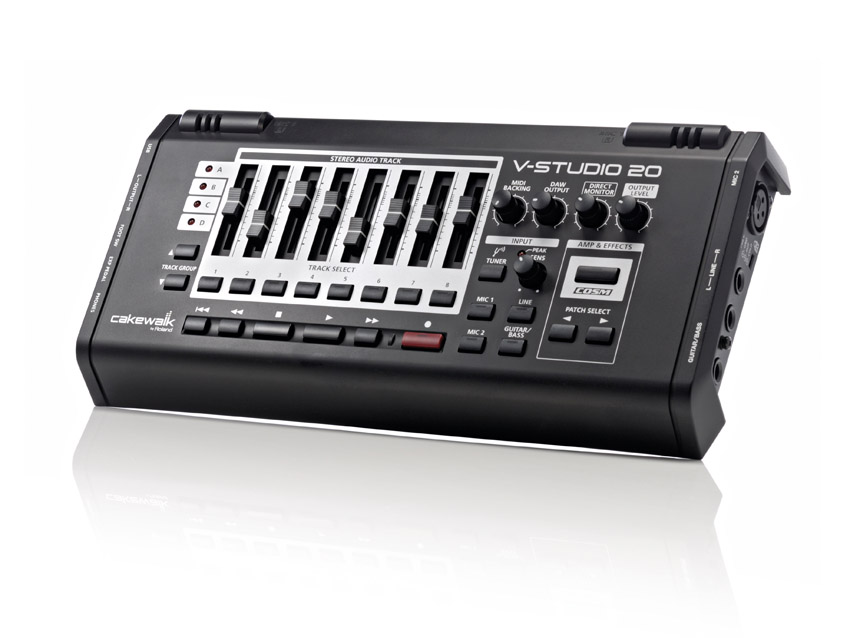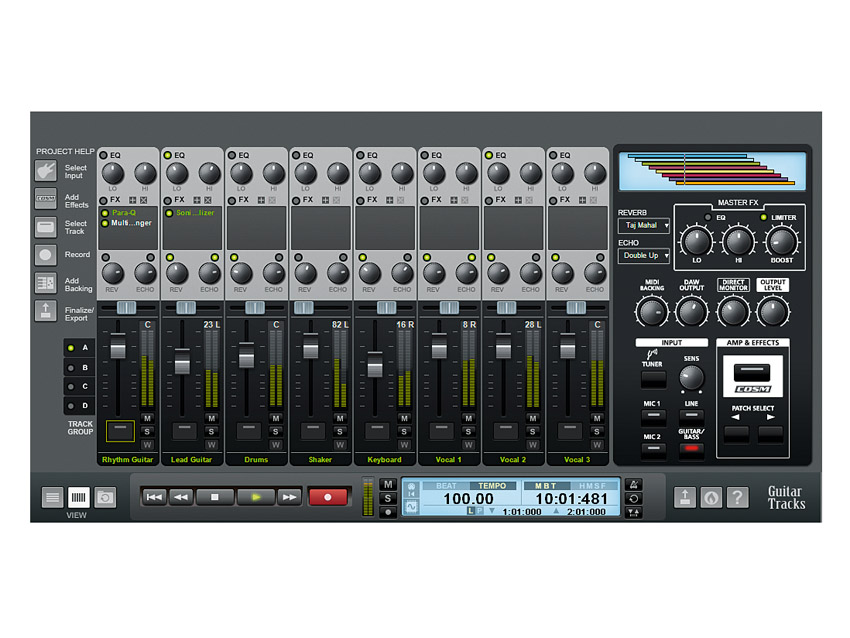MusicRadar Verdict
Despite its shortcomings, the V-Studio 20 is a good entry-level package, with an emphasis on recording immediacy.
Pros
- +
Straightforward operation. Built-in mics are very handy. Decent DSP effects with easy 'reamping'. Minimal CPU hit, even on netbooks!
Cons
- -
Dodgy timestretching. MIDI backing doesn't go through mixer. Supplied audio/MIDI content is poor. No hardware undo feature.
MusicRadar's got your back

Cakewalk V-Studio 20

Cakewalk V-Studio 20

Cakewalk V-Studio 20
The V-Studio series from Cakewalk/Roland has thus far aimed to provide a complete production environment, but the new VS-20 has a far simpler remit: it's for guitarists who want to get into software recording but crave the simplicity of yesteryear's standalone hardware recorders.
The package consists of the VS-20 hardware and PC-only Guitar Tracks 4 software, and it's billed as being 'netbook ready', hence we used a Samsung NC10 netbook for this review.
At 30cm wide, the VS-20 hardware is about 5cm wider than your average netbook. It feels good if not exactly rugged, but it'll surely last if you're sensible with it. The I/O ports are on the left and right sides, to facilitate plonking the device right in front of your laptop.
"The built-in mics are perfect for capturing fleeting ideas."
On the left, you've got a USB port; stereo out on RCA jacks; and 1/4" jacks for dual footswitch, expression pedal (for wah/volume) and headphones. On the other side, you'll find a high-impedance 1/4" input for guitar/bass; stereo line in on 1/4" jacks; and an XLR mic input with phantom power. It's got a pair of built-in stereo mics, too.
Guitar Tracks lets you record up to 32 tracks of audio and has two main screens. The Track view is your typical DAW arranger, with features like snap to grid, clip fades, track freeze, etc.
Console yourself
The other screen, Console view, corresponds to the VS-20's controls. The channel levels can be controlled with the VS-20's faders, using the 'track group' buttons to access them in banks of eight. Tracks can be armed via the Track Select buttons, and there's a transport strip too.
You can record volume automation using the VS-20's faders (and manually draw in curves for other parameters, including those of plug-ins). The input panel lets you select from line, guitar/bass, mic input and the built-in mic.
The input is stereo-only, so you can't record from all inputs at once. Recording levels are set with the Peak Sens. knob, which has an overload LED. Levels for MIDI backing, DAW output, direct monitoring (with COSM effects) and output level can also be set.
The MIDI backing has its own track - you can't edit note data at all, but you can disable channels, eg, to isolate the drums. Speaking of backing tracks, there's about 1GB of included sound content, in various tempos and genres. You get band (full mix) and drum audio loops, and 400MB of full-length songs.
It's a real mixed bag, and the songs are of no real use - many are just embarrassing. Guitar Tracks will timestretch audio to fit your song, but it's prone to buzzing/flamming artifacts. The MIDI loops are more useful, but you only get ten.
Guitar Tracks' mixer is simple. Each track has level, panning, solo/mute, high/low shelving EQ, insert effects, and sends for the Reverb and Echo modules. Of these last two, you can choose from about 15 presets each - there are no tweakable parameters, but the delays do sync to the beat.
On the master output, you have high/low shelving EQ and a limiter, but no inserts. Bizarrely, the TTS-1 virtual instrument that produces the MIDI sounds does not go through the mixer, so you can't apply, say, EQ to MIDI backings - it doesn't even go through the master EQ/limiter. You can set the TTS-1 as an audio track source, to come through the mixer, but then you can't use the MIDI Backing level knob.
Of the supplied effects, you get the good-old Sonitus:fx Equalizer, AliasFactor bitcrusher, Classic Phaser, Compressor/Gate, HF Exciter, Modfilter, Multivoice Chorus/Flanger, Para-Q, Studioverb2 and Tempo Delay. It's a solid selection, and VST plug-ins are supported, too.
Reamp for the masses
The VS-20 hardware features a built-in Boss COSM guitar/vocal processor, for live monitoring and recording. You can also record the dry signal (whilst monitoring with effects) and later 'reamp' it through the COSM processor and record the results to a new track, so you can change the tone after recording.
In fact, you can reamp any signal, so you could, say, use the harmoniser to create new vocal lines on separate tracks. It's easy to do, too.
The V-Studio 20 hardware should allow you to forget about the keys and mouse, and it does, to an extent. You can even assign the footswitch to commands like play/stop, record, tuner, as well as COSM effects toggling options.
However, if you record a bad take, there's no way to undo it from the hardware, so you have to hit Ctrl-Z anyway. You can't just record over it because Guitar Tracks 'stacks' the two takes and plays them together. This behaviour can be changed in the options, but it should be ready to go.
If you outgrow Guitar Tracks, you can buy the Pro version, or even Sonar (which loads Guitar Tracks projects), and you'll still be able to use the hardware as an interface and controller.
It works as a Mackie Control device for other DAWs, and while Guitar Tracks doesn't run on Mac, you can use the hardware and COSM effects under OS X.
COSMic bomb
Hit the COSM button on the VS-20 (or in Guitar Tracks) and the VS-20 Editor app is launched. It appears like a Boss floor pedal, and indeed, the effects use Boss algorithms.
They run on a DSP chip inside the hardware, so unlike using plug-in effects in Guitar Tracks' mixer, they won't tax your computer's CPU at all, and they won't be subject to DAW latency either - ideal for netbook use! Just think of it as a Boss multieffects pedal stuffed inside the hardware.
Guitar amp models cover all the usual suspects, including a bass amp. They're not in the same league as the current crop of plug-in amp sims, but they're usable enough.
The vocal processor is of a similar level of quality and it can be used in place of the amp sim. It offers pitch correction (ie, autotune) with three different speeds (from slow and gentle to 'T-Pain') and intelligent, in-key harmonisation - something of a rarity in plug-in land.
The four stomp pedals cover compression/FX, overdrive/distortion, modulation and delay. We particularly enjoyed the lush modulation effects and the Slow Gear automatic volume swell (which provided the 'pad' sound in our demo tune).
Additionally, there's a sweet one-knob room/hall reverb (that's well worth reamping through), a noise gate, tuner, and presets aplenty.
A fond farewell
While we've raised a few grumbles here, we're actually quite fond of the V-Studio 20 and were sorry to see it leave. Sure, it's not perfect, but it's still very straightforward, and we had fun using it.
The mixer is a doddle to use and the COSM effects offer further immediacy. We didn't have any CPU problems recording track upon track with our netbook.
The built-in mics are perfect for capturing fleeting ideas. Understandably, they don't sound amazing, but they're clean and quite sensitive - we used them for the acoustic guitar and finger snaps in our demo tune.
All in all, the V-Studio 20 isn't quite what it could be, but it's still a good buy for guitarists looking to get into computer music, and it does bring back the spontaneity of portable multitrackers. It's also a smart option for netbook users after a portable 'power up'.
Now listen to our audio demos to hear a few of the V-Studio's presets:
'60s Fuzz
Blues Lead
Clean Chorus
Metal Riff
Synthy Lead
Touch Wah Funk
Computer Music magazine is the world’s best selling publication dedicated solely to making great music with your Mac or PC computer. Each issue it brings its lucky readers the best in cutting-edge tutorials, need-to-know, expert software reviews and even all the tools you actually need to make great music today, courtesy of our legendary CM Plugin Suite.
“A synthesizer that is both easy to use and fun to play whilst maintaining a decent degree of programming depth and flexibility”: PWM Mantis review
“I feel like that song had everything we needed to come back with”: Bring Me The Horizon’s Lee Malia on Shadow Moses, its riff and the secrets behind its tone, and why it was the right anthem at the right time
“I said, ‘Are we sure we can write a song about death?’”: The story of Mike + The Mechanics' classic No.1 The Living Years










